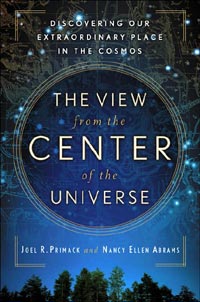|
|
Review: The View from the Center of the Universe
by Jeff Foust
Monday, October 16, 2006
The View from the Center of the Universe: Discovering Our Extraordinary Place in the Cosmos
by Joel R. Primack and Nancy Ellen Abrams
Riverhead Books, 2006
harcover, 400 pp., illus.
ISBN 1-59448-914-9
US$26.95/C$38.00
The award of the Nobel Prize in Physics earlier this month to astronomers John Mather and George Smoot for their work confirming the existence of the cosmic microwave background, a key piece of evidence in support of the Big Bang model of the formation of the universe, has doubtless (re)awakened interest among many members of the general public about the Big Bang and cosmology in general. This field, after all, seeks to answer one of the most fundamental questions in human existence: how did the universe come to be? It’s a question that many science books have tried to answer, as best they could given the current state of knowledge about the universe, but none in quite the same way as Joel Primack and Nancy Ellen Abrams attempt to do in The View from the Center of the Universe.
At first glance this book, written by a husband-and-wife team (he’s an astronomer, she’s a lawyer and writer), treads familiar ground. They review how scientific discoveries over the last several hundred years, and in particular the last century, have reshaped our view of the universe, and our place within it. During that time astronomers have displaced us from our long-held perch at the center of the universe to a planet orbiting an ordinary star, one of hundreds of billions in the Milky Way galaxy, which in turn may be one of hundreds of billions of galaxies in the universe. (Not to mention the possible existence of other universes.) It’s hardly the first time someone has tried to humble readers about our place in the universe: as Carl Sagan once said, in a passage included in the book, “In this perspective, how can anyone seriously believe that we are central—physically, much less to the purpose of the universe?”
| The book is a reminder that cosmology is much more than simply determining the age of the universe and the ratio of visible matter to dark matter and dark energy. |
It’s here, though, that The View from the Center of the Universe diverges from other books about cosmology and the universe. Primack and Abrams move from astronomy into fields like history, philosophy, and even social activism in a quest to restore humanity to the center of the universe. This “centrality”, though, exists on a different basis: one of size (humans are roughly midway between the largest and smallest structures in the universe) and of time. It also means, in the view of the authors, of taking the long view and acting accordingly to ensure the future of humanity.
That kind of discussion—as well as related points on topics like sustainable growth and income inequality—might seem out of place in a book about cosmology, and it’s something that might rub some readers the wrong way. The View from the Center of the Universe is, though, a reminder that cosmology is much more than simply determining the age of the universe and the ratio of visible matter to dark matter and dark energy. It is, at its roots, an essential part of humanity’s quest to determine our place in the universe, and something even today not necessarily exclusively in the realm of science.
Jeff Foust (jeff@thespacereview.com) is the editor and publisher of The Space Review. He also operates the Spacetoday.net web site and the Space Politics and Personal Spaceflight weblogs. Views and opinions expressed in this article are those of the author alone, and do not represent the official positions of any organization or company, including the Futron Corporation, the author’s employer.
|
|
